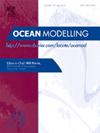The role of driving forces in sediment transport processes in an upwelling-driven continental shelf
IF 2.9
3区 地球科学
Q2 METEOROLOGY & ATMOSPHERIC SCIENCES
引用次数: 0
Abstract
Sediment transport in the continental shelf regions affects many interdisciplinary problems, including ecological and social issues. Understanding the underlying processes influencing sediment transport is essential for coastal management, distribution of nutrients, pollutants and abundance of benthic flora and fauna, which can impact the entire food chain in the marine ecosystem. The present work aims to enhance our understanding of the spatial and temporal variability of sediment transport in the upwelling affected continental shelves. A state-of-the-art 3D oceanic numerical model CROCO (v1.0) was used to simulate the suspended sediment transport on NW Iberian Peninsula continental shelf, considering an entire annual cycle from November 2008 to December 2009. The sediment transport patterns were influenced by the seasonality of the shelf current and wave dynamics. While low sediment movement was observed during spring and summer, considerable transport could be seen from mid-autumn and winter, associated with storms. The shelf circulation, mainly driven in response to atmospheric forcing, determined the transport direction, while wave energy regulated the re-suspended sediment mass. Storm-driven upwelling and downwelling events predominantly promoted sediment transport southward and northward through the bottom boundary layer, respectively. The morphological features of the shelf and the frontal dynamics between the oceanic and fresh water in the mid-and inner shelf, modulated by upwelling and downwelling, shaped the suspended sediment transport across and along the water column. In the northern region of the study area, the simulated shelf-scale near-bottom eddies induced transport pathways to the open ocean.
上升流驱动的大陆架沉积物输运过程中驱动力的作用
大陆架区域的泥沙运移影响着许多跨学科的问题,包括生态和社会问题。了解影响沉积物运输的潜在过程对于沿海管理、营养物分布、污染物和底栖动植物丰富度至关重要,这可能影响海洋生态系统中的整个食物链。本研究旨在提高我们对受上升流影响的大陆架沉积物输运时空变异性的认识。利用三维海洋数值模型CROCO (v1.0)模拟了伊比利亚半岛西北大陆架的悬沙输运,考虑了2008年11月至2009年12月的整个年周期。沉积物输运模式受陆架洋流和波浪动力的季节性影响。春季和夏季沉积物运动较少,而秋季和冬季则出现了大量与风暴有关的输沙。主要受大气强迫驱动的陆架环流决定了输运方向,波能调节了再悬质。风暴驱动的上升流和下升流事件主要促进沉积物分别通过底部边界层向南和向北运移。陆架的形态特征以及陆架中部和内部海洋与淡水的锋面动力学,在上升流和下升流的调节下,决定了悬浮物在水柱上和水柱上的运移。在研究区北部,模拟的陆架尺度近底涡流诱导了向公海的运输路径。
本文章由计算机程序翻译,如有差异,请以英文原文为准。
求助全文
约1分钟内获得全文
求助全文
来源期刊

Ocean Modelling
地学-海洋学
CiteScore
5.50
自引率
9.40%
发文量
86
审稿时长
19.6 weeks
期刊介绍:
The main objective of Ocean Modelling is to provide rapid communication between those interested in ocean modelling, whether through direct observation, or through analytical, numerical or laboratory models, and including interactions between physical and biogeochemical or biological phenomena. Because of the intimate links between ocean and atmosphere, involvement of scientists interested in influences of either medium on the other is welcome. The journal has a wide scope and includes ocean-atmosphere interaction in various forms as well as pure ocean results. In addition to primary peer-reviewed papers, the journal provides review papers, preliminary communications, and discussions.
 求助内容:
求助内容: 应助结果提醒方式:
应助结果提醒方式:


